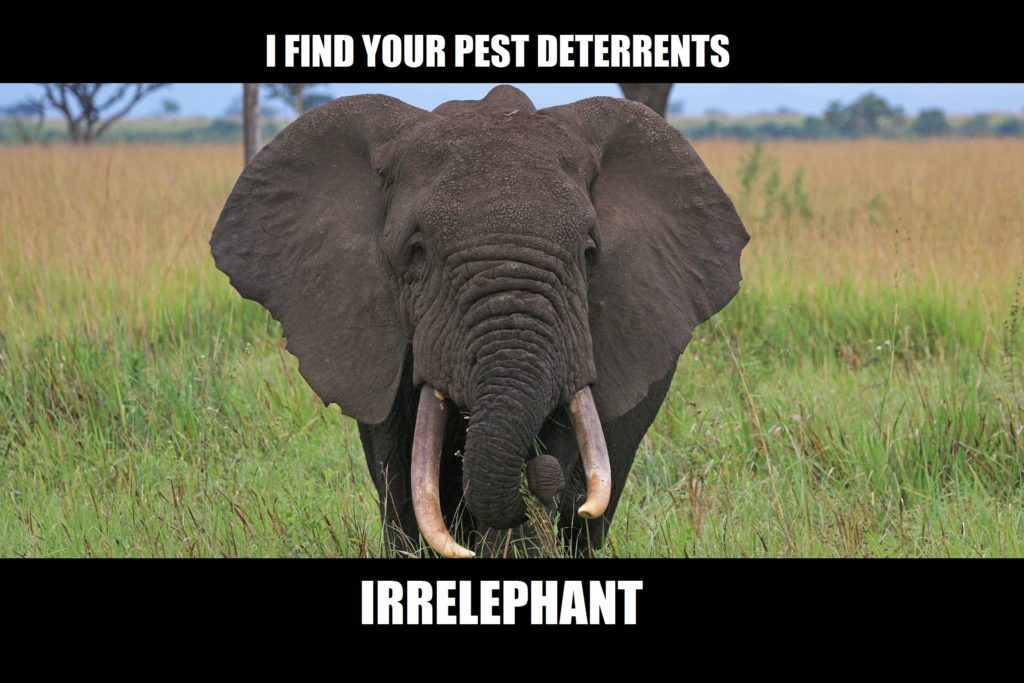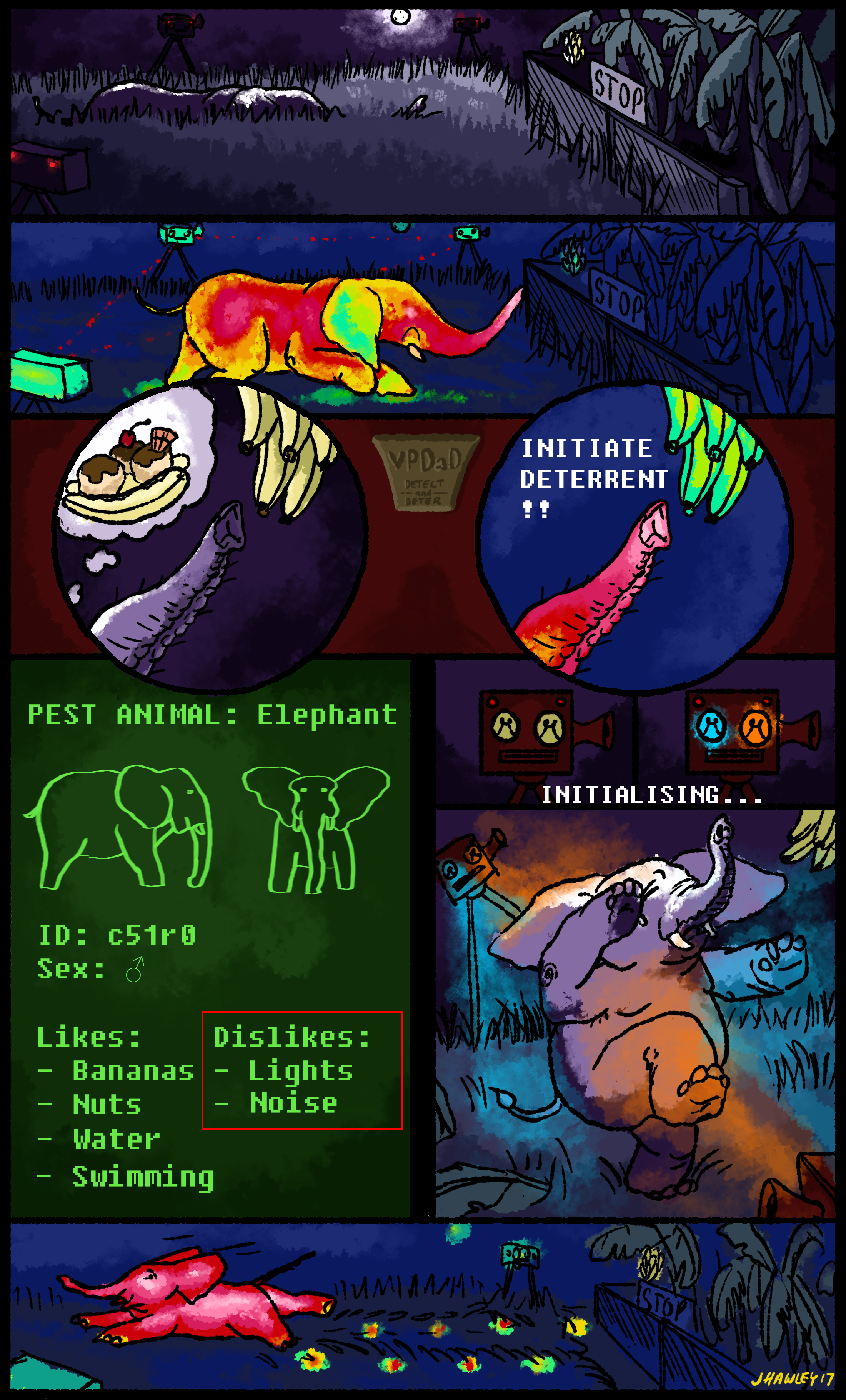The world to VPDaD (not Predator) — the Vertebrate Pest Detect-and-Deter. Comic by CSIRO/Jesse Hawley.
You might not spend too much time thinking about elephant crop raiding. But for rural farmers in African countries, it’s no joke – it can seriously affect their livelihoods.
Elephants are capable of destroying an entire season’s worth of crops in one night, which can be economically devastating to farming communities.
Humans haven’t always made life easy for elephants, with poaching and habitat destruction severely affecting their numbers. Finding a solution that protects crops without any further harm to the elephants is crucial.
So we’ve collaborated with agribusiness company Olam International to develop a humane deterrent: technology that scares away the elephants and protects the farmer’s livelihood.
We’ve trialled the technology – called Vertebrate Pest Detect-and-Deter (VPDaD) – in Gabon, Africa, and it successfully scared away elephants from nut and banana plantations, using a combination of sensors and very clever software.
Like something out of James Bond: the Sentinel, and technology that adapts
At first glance, you might not realise VPDaD is advanced technology – similar to the simple-looking gadgets Q would dig out for Mr Bond. But dig a little deeper and you’ll find VPDaD is made up of two parts: a motion sensor device, and a collection of cameras that can pick up images and heat signatures of an animal, with lights and sounds which function as the deterrent for pests.
Sure, you might be thinking, that sounds good. But elephants are smart. Surely they figure out that the sounds aren’t a threat and eventually build up a tolerance to them? Or even realise that when they hear the startling noises, there’s food nearby?
You’d be right, and that’s an issue with existing deterrent technology. But we’ve planned for that.
VPDaD analyses the images, recognises and classifies the animals detected, and then chooses the best type of deterrent to scare that animal away. And if that doesn’t work, it learns, and picks a different deterrent until it succeeds.

Adapting VPDaD for Australian pests
While we don’t have elephants to contend with here in Australia, we do have our fair share of pests and crop raiders, estimated to cost our economy up to a whopping $1 billion every year.
We’ve adapted our VPDaD technology for Australian pests, and we’re doing feasibility work in Queensland’s Lockyer Valley. We’re also looking to partner with local agribusiness to continue testing and trialling the technology in Australia.
The main focus for Australian agriculture is protecting orchards, vegetable and cereal crops from vertebrate pest animals like rabbits, feral pigs, wallabies, foxes, dingoes, and even ducks and cockatoos – they all have expensive tastes, and can cause thousands of dollars damage in a single dining experience.
Interested in partnering with us on this project?



11th September 2017 at 5:40 pm
Does electric fencing not deter Kangaroos?
23rd August 2017 at 10:10 am
Well done to the teams from Bi-Security and Data61 for developing the technology and a special thanks Dr Paul De Barro for his great support for this work. Members from the Data61 Distributed Sensing Systems and Robotics and Autonomous Systems groups have been working over the weekends to get the technology ready for an African trial which is underway right now!
Here are some links to the groups other research;
https://research.csiro.au/dss/
https://research.csiro.au/robotics/
15th August 2017 at 4:34 pm
That’s brilliant! motion sensors, heat cameras, sounds and lights? I’m not kidding when I say that would even scare ME away! I don’t care how many times those lights and sounds start up, those bananas still wouldn’t be worth the fright lol. Got to take my hat off to the people who made this happen, well done.
11th August 2017 at 10:44 pm
What is available to deter Eastern Grey kangaroos from areas requiring protection such as environmentally vulnerable areas, crops and roads? Is there an opportunity to help develop and/or perfect systems or devices for this purpose. I have 150 Ha of grazing land near Yass which has constant ‘roo pressure making effective pasture management impossible for much of the property. This has a continuing and profound affect on the biodiversity of our native grasslands. I would be very pleased receive advice on research and to assist in this area. I am aware some devices are used to detect and repel birds from ripening grapes, surely similar methods can be developed for other animals.
In hope and curiosity, Jeremy Wilson
9th August 2017 at 3:41 pm
Sounds great in principle but extremely unlikely to work for more than the short term. The animals will habituate extremely rapidly and this supremely acronym rich system will fail. Plus, this is AFRICA.